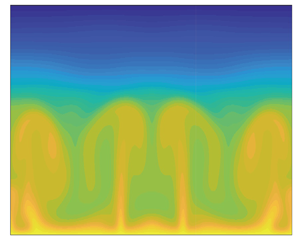Article contents
Coherent heat transport in two-dimensional penetrative Rayleigh–Bénard convection
Published online by Cambridge University Press: 15 June 2021
Abstract

This paper investigates the steady coherent solutions, bifurcated from the linear stability of a stationary flow, in two-dimensional (2-D) penetrative convection. The results show that the thickness of the upper stably stratified layer, which is measured by  $\theta _M$ (the dimensionless temperature at which the density is maximal, with
$\theta _M$ (the dimensionless temperature at which the density is maximal, with  $0\le \theta _M\le 1$), plays an important role in the linear and nonlinear dynamics. First, we investigate steady solutions of fixed aspect ratio
$0\le \theta _M\le 1$), plays an important role in the linear and nonlinear dynamics. First, we investigate steady solutions of fixed aspect ratio  $L=2{\rm \pi} /\alpha _c$ (where
$L=2{\rm \pi} /\alpha _c$ (where  $\alpha _c$ is the critical wavenumber). The results show that the instability is supercritical when
$\alpha _c$ is the critical wavenumber). The results show that the instability is supercritical when  $\theta _M<0.4$ and is subcritical when
$\theta _M<0.4$ and is subcritical when  $\theta _M>0.4$. When
$\theta _M>0.4$. When  $\theta _M>0.4$, the results show that the type of solution depends on the Prandtl number (
$\theta _M>0.4$, the results show that the type of solution depends on the Prandtl number ( $Pr$). For instance, when
$Pr$). For instance, when  $Pr\lesssim 2.4$ at
$Pr\lesssim 2.4$ at  $\theta _M=0.5$, the solution in one type of pair of convection cells does not exist, as the Rayleigh number
$\theta _M=0.5$, the solution in one type of pair of convection cells does not exist, as the Rayleigh number  $Ra$ exceeds a critical value due to a saddle-node bifurcation. When
$Ra$ exceeds a critical value due to a saddle-node bifurcation. When  $Pr>2.4$, steady solutions can be found up to
$Pr>2.4$, steady solutions can be found up to  $Ra=10^{8}$ for all
$Ra=10^{8}$ for all  $\theta _M$, which exhibit the scaling of heat transfer (characterized by the Nusselt number
$\theta _M$, which exhibit the scaling of heat transfer (characterized by the Nusselt number  $Nu$):
$Nu$):  $Nu\sim Ra^{1/4}$. Then, the optimal 2-D steady solutions are tracked up to
$Nu\sim Ra^{1/4}$. Then, the optimal 2-D steady solutions are tracked up to  $Ra=10^{9}$ by varying the aspect ratio
$Ra=10^{9}$ by varying the aspect ratio  $L$, which shows that heat transfer roughly follows the
$L$, which shows that heat transfer roughly follows the  $Nu\sim Ra^{\gamma }$ (
$Nu\sim Ra^{\gamma }$ ( $\gamma \approx 1/3$) scaling in the regime of
$\gamma \approx 1/3$) scaling in the regime of  $10^{7}< Ra<10^{9}$. It is interesting that the optimal temperature field has an arm-like horizontal structure when
$10^{7}< Ra<10^{9}$. It is interesting that the optimal temperature field has an arm-like horizontal structure when  $Pr<10$, while it has no significant horizontal structures when
$Pr<10$, while it has no significant horizontal structures when  $Pr>10$. Thus, the mean temperature in the mixing region is higher at large
$Pr>10$. Thus, the mean temperature in the mixing region is higher at large  $Pr$. The steady solutions show that
$Pr$. The steady solutions show that  $Nu\sim Pr^{-1/12}$ for
$Nu\sim Pr^{-1/12}$ for  $\theta _M=0$ in a certain range of
$\theta _M=0$ in a certain range of  $Pr$ by fixing the Rayleigh numbers, e.g.
$Pr$ by fixing the Rayleigh numbers, e.g.  $1< Pr<10$ for 2-D optimal steady solutions at
$1< Pr<10$ for 2-D optimal steady solutions at  $Ra=10^{8}$ and
$Ra=10^{8}$ and  $2< Pr<30$ for 2-D steady solutions of fixed aspect ratio at
$2< Pr<30$ for 2-D steady solutions of fixed aspect ratio at  $Ra=10^{7}$. But when the Prandtl number is large or the upper stably stratified layer is thick, both the steady solutions of fixed aspect ratio and the 2-D optimal steady solutions are very weakly dependent on
$Ra=10^{7}$. But when the Prandtl number is large or the upper stably stratified layer is thick, both the steady solutions of fixed aspect ratio and the 2-D optimal steady solutions are very weakly dependent on  $Pr$.
$Pr$.
JFM classification
- Type
- JFM Papers
- Information
- Copyright
- © The Author(s), 2021. Published by Cambridge University Press
References
REFERENCES
- 4
- Cited by





